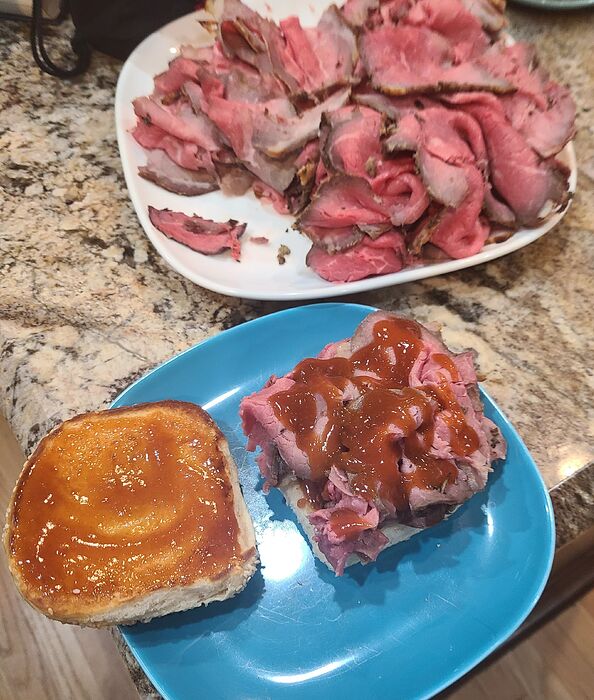And then there are ‘boneless wings’, which are actually pieces of breast.
A wing is now a preparation (fried, sauced) rather than a body part
![]()
And in Ohio, the court has ruled that consumers should obviously know that a menu item called “boneless wings” may, in fact, contain bones, and if the consumer chokes on one, that’s their own fault.
I skimmed it, assumed they were talking about SV. I’ve done it like this before, but I prefer a higher temp. It’s super juicy but is like… mushy? I like SV chicken and turkey breast at 140+, like mid 140s at least feels like it’s poultry.
Yeah I saw that. I actually agree with the court, they’re just saying nothing is 100% perfect.
I guess restaurants could add onto their raw/ under-cooked food warnings. A lot of packaged products do have a warning, such as mechanically pitted olives or cherries.
Would it make a difference if you raised and harvested your chickens. Knowing where they came from ? Im not afraid of a little pink. . For me
I know where the chickens came from . I like them cooked through preferably. Ground beef is a different story . When i cook a burger patty . Its cooked rare .
For very tender poultry and meat, just slice or chunk it no thicker than a half inch, slosh in diluted baking soda for 10 minutes, rinse, pat dry, and saute or fry. I am sure this method is why the meats in the dishes from a nearby Thai place (Khao Hom Thai) are always fork tender. Though a longtime customer, I have only ever gotten delivery from them so haven’t asked them.
That’s called “velveting” the meat. It’s also a useful prep for shrimp and other seafood, although for shrimp it’s more about texture and moisture retention.
Kenji recommends a combo of 1 tsp salt and 1/4 tsp bicarb per pound shrimp and it does seem to help. I made a coconut red curry shrimp dish last night and 3 of our dinner attendees were delayed, and the dish sat on heat an unexpected extra half hour, and the 3 pounds of shrimp were still plump and tender.
I think you mean Flats and Drumettes (Tips are the remaining bit on the Wing)
Thighs and Drumsticks(Calves ![]() ) form the Leg.
) form the Leg.
Yes, of course. I knew there was something weird about it when I wrote that!
Better brush up on my ornithological anatomy knowledge, eh? ![]()
Love that scarred, almost broken Heart Tomato.
Thank you! I knew I had to keep that pic when I took it last year of this FM find.
I never thought of it as a scar, but rather a smile … and captioned it as such over on the Book of Faces with “Smile, love!”
Must be my overall sunny disposition ![]()
Eye-round is my go to cut for medium rare roast beef sandwiches, but even sliced very thin, it can be tough, as you mention. So I’d like to try the longer-term cooking at some point. Pic of my eye round below.
To what temp internal temp do you cook it?
Also, is there a point of no additional return? Was 24 hours noticeably better than 12, and 12 better than 6?
I watched a video where Guga had a brisket in sous vide for 30 days (if you haven’t seen him, he does a lot of goofy stuff on a lark or at the request of viewers and his sponsors). Let’s just say it did not turn out well…
LOL!! Love your wishywashiness. I’m +1 to both those posts. I can’t wrap my head around it. My head has suffered too many wraps.
I did it to 131 degrees for 24 hours, followed by searing on all sides in a hot cast iron skillet.
I think 131 is the minimum temp that will definitely kill all the nasties given enough time, which is important if you’re letting it hang out at those temps for the extended periods required to tenderize tougher cuts.
Used the sous vide liquid left in the bag to make a pan sauce.
As for the 12-24-36-48 hour question, Guga tested this out somewhat. If I recall correctly, too much past 24 and things started to get “mushy”. I also suppose this would depend on your particular cut, and how much intramuscular fat it had. A more marbled roast might be more tender at the same time/temp. Mine was just your bog standard USDA Choice grocery store beef, so was fairly lean. 24 hours gave me a pink color and a decent texture, maybe a little more chewy than I’d like.
Maybe I’ll go 30 hours next time and see what happens.
Thanks much!
There’s a well known 72-hour method for tough cuts.
I liked 50-60h a bit better after a few iterations.
You can also start with a few chunks and leave them in for varying lengths of time if you want to compare them as an experiment.
Technically I believe it’s a “zipper”. In case that’s what we’re talking about.
Do you know the cause of it?
From the linked "Gardening Know How " article
“Zippering is similar, but not the same, to catfacing in tomatoes. Both are caused by pollination problems and lower temperature fluxes.”
I could probably trust that. The hot CI skillet pop should make it much more attractive and texturally improved.


